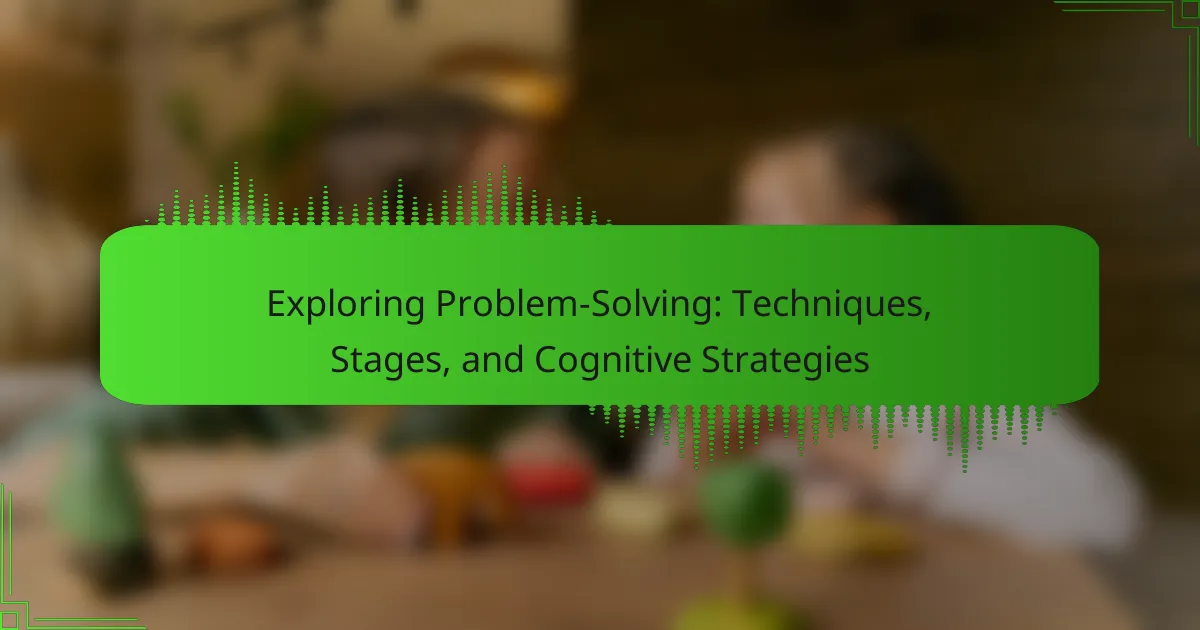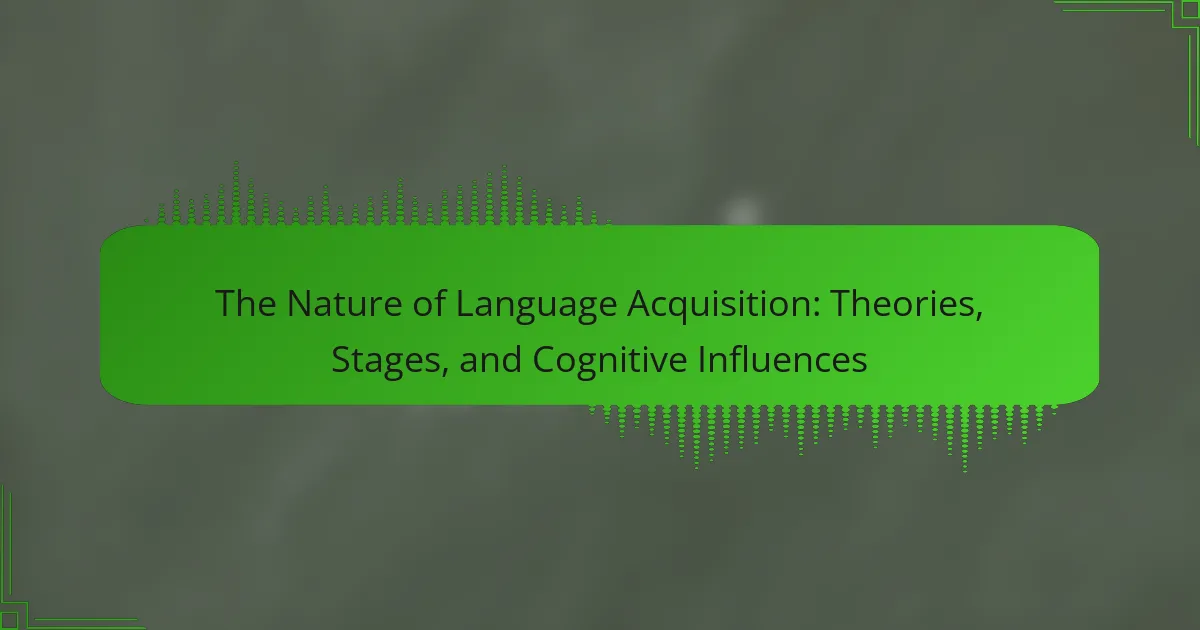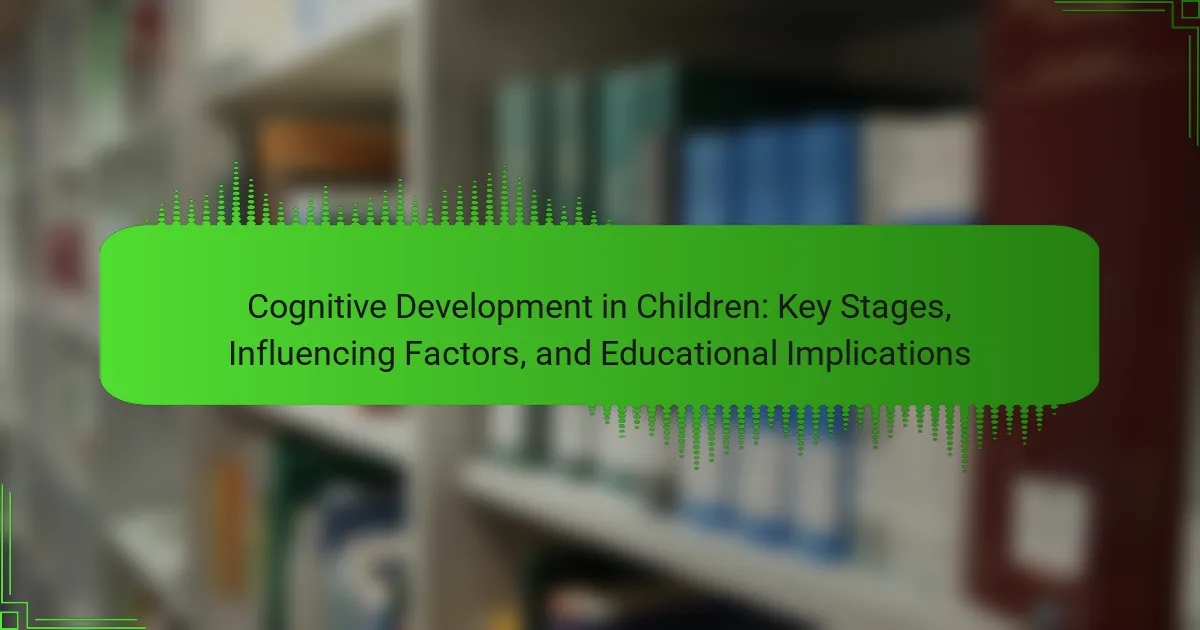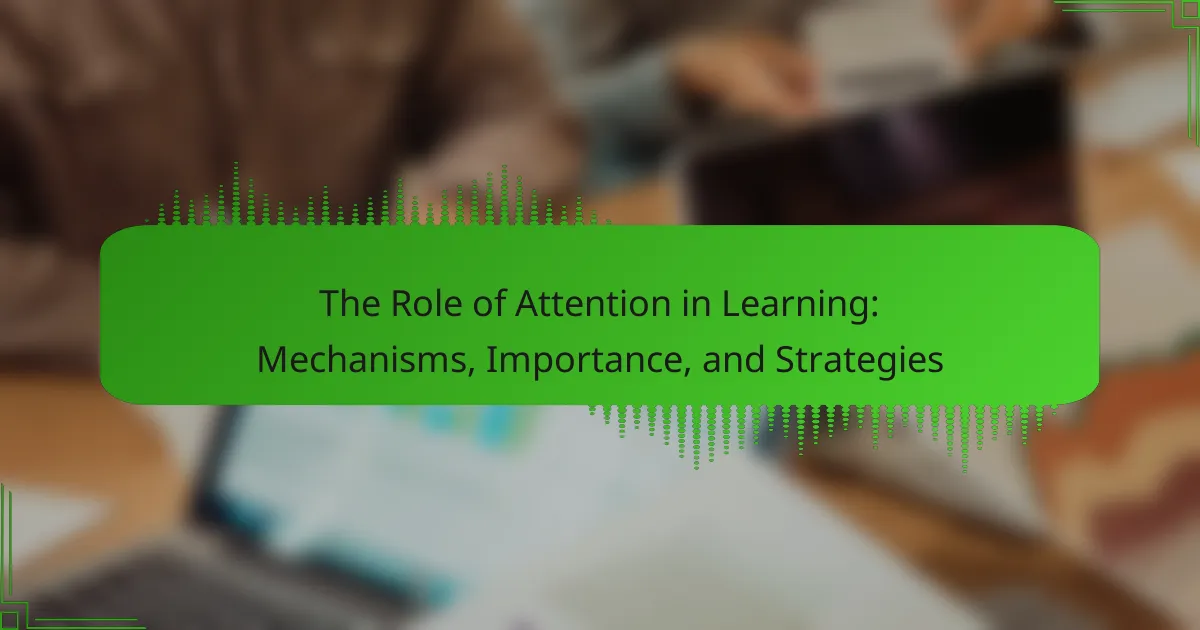Problem-solving is the process of identifying challenges and finding effective solutions across various contexts, including personal, academic, and professional environments. This article explores the stages and techniques involved in problem-solving, emphasizing the cognitive strategies that enhance decision-making and critical thinking skills. Research highlights that structured problem-solving can lead to improved academic performance, underscoring its significance as a fundamental cognitive skill. Key topics include the stages of problem-solving, effective strategies, and the impact of these techniques on overall cognitive development.
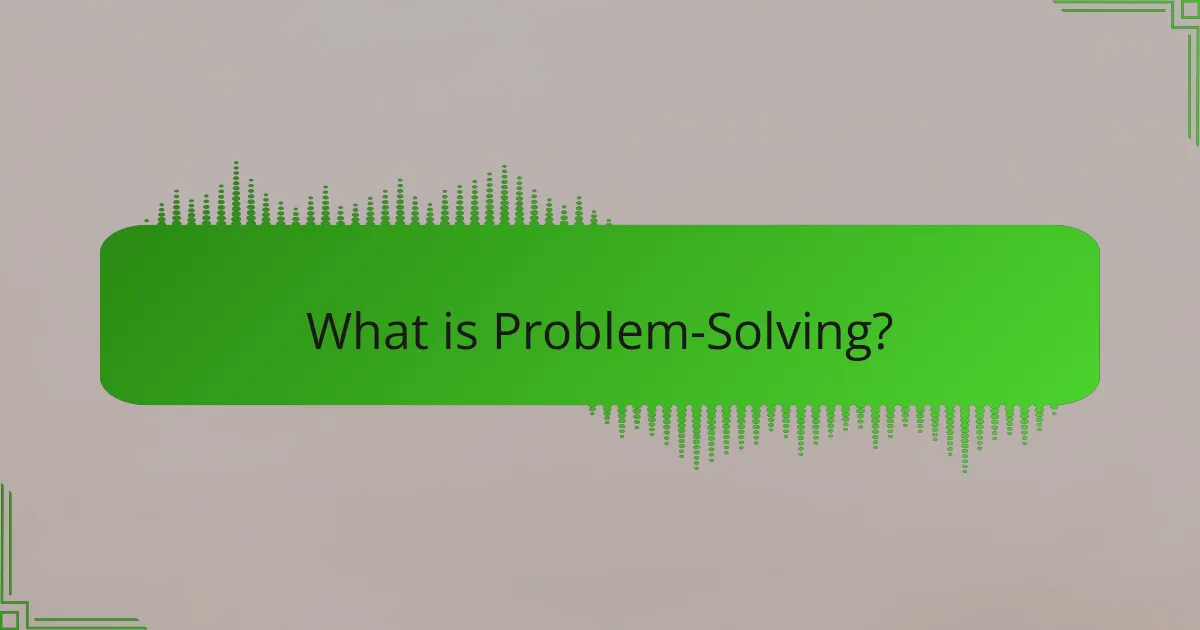
What is Problem-Solving?
Problem-solving is the process of identifying a challenge and finding a solution. It involves recognizing the problem, analyzing the situation, and implementing effective strategies. Problem-solving can occur in various contexts, including personal, academic, and professional environments. Research indicates that effective problem-solving enhances decision-making and critical thinking skills. According to a study published in the Journal of Educational Psychology, students who engage in structured problem-solving demonstrate improved academic performance. This underscores the importance of problem-solving as a fundamental cognitive skill.
How is Problem-Solving defined in various contexts?
Problem-solving is defined as the process of identifying a challenge and finding solutions. In education, it emphasizes critical thinking and analytical skills. In business, it involves strategic decision-making to overcome obstacles. In psychology, it relates to cognitive processes used to resolve conflicts. In engineering, it focuses on applying technical knowledge to create effective solutions. Each context highlights different methodologies and approaches tailored to specific challenges. For instance, educational problem-solving often includes collaborative learning techniques. Business contexts may utilize data analysis and market research to inform decisions.
What are the key characteristics of effective Problem-Solving?
Effective problem-solving involves several key characteristics. These include analytical thinking, creativity, and decisiveness. Analytical thinking enables individuals to break down complex problems into manageable parts. Creativity fosters the generation of innovative solutions. Decisiveness is essential for making timely decisions based on the available information. Additionally, effective problem solvers demonstrate persistence and adaptability. Persistence helps them stay focused on finding solutions despite challenges. Adaptability allows them to adjust their approaches as necessary. Research indicates that these characteristics significantly enhance problem-solving outcomes. A study by D’Zurilla and Nezu (2007) highlights the importance of these traits in effective problem resolution.
Why is Problem-Solving considered a critical skill?
Problem-solving is considered a critical skill because it enables individuals to identify solutions to complex issues. This skill is essential in both personal and professional contexts. Effective problem-solving leads to improved decision-making and increased efficiency. According to a study by the World Economic Forum, problem-solving ranks among the top skills needed for the workforce. Organizations prioritize this skill for innovation and adaptability. Furthermore, research shows that strong problem-solving abilities correlate with higher job performance. Therefore, mastering problem-solving enhances both individual capabilities and organizational success.
What are the stages of Problem-Solving?
The stages of problem-solving are typically defined as a series of steps. These steps include identifying the problem, generating potential solutions, evaluating options, and implementing the chosen solution.
Identifying the problem involves recognizing and articulating the issue at hand. Generating potential solutions requires brainstorming possible ways to address the problem. Evaluating options means assessing the feasibility and effectiveness of each solution. Finally, implementing the chosen solution involves putting the selected option into action.
These stages provide a structured approach to effectively tackle challenges. Research shows that following these steps can lead to more successful outcomes in various contexts, including personal and professional settings.
How do you identify the problem in Problem-Solving?
To identify the problem in problem-solving, first clearly define the issue at hand. This involves gathering relevant information and understanding the context. Next, analyze the symptoms of the problem to distinguish between the actual problem and its effects. Engage in questioning techniques, such as the “5 Whys,” to delve deeper into the root cause. Document your observations to create a clear picture of the problem. Collaborate with others to gain different perspectives, which can reveal insights that may have been overlooked. Finally, verify your understanding by summarizing the problem and confirming it with stakeholders. This structured approach ensures a comprehensive identification of the problem, facilitating effective problem-solving.
What methods are used to analyze options in Problem-Solving?
Decision matrix analysis is a common method used to analyze options in problem-solving. This method involves listing options and scoring them against various criteria. Each option is evaluated based on how well it meets each criterion. The scores are then totaled to identify the best option. Another method is cost-benefit analysis. This assesses the financial implications of each option. It compares the expected benefits against the costs involved. SWOT analysis is also utilized. It examines strengths, weaknesses, opportunities, and threats related to each option. These methods provide structured frameworks for evaluating choices effectively.
What techniques can enhance Problem-Solving?
Techniques that can enhance problem-solving include brainstorming, root cause analysis, and the use of heuristics. Brainstorming encourages the generation of diverse ideas without immediate judgment. This technique fosters creativity and can lead to innovative solutions. Root cause analysis helps identify the underlying issues causing a problem. By addressing these root causes, more effective solutions can be developed. Heuristics are mental shortcuts that simplify decision-making processes. They allow individuals to make quicker judgments based on experience. Research shows that these techniques improve problem-solving efficiency and effectiveness. For instance, a study by Osborn in 1953 highlighted the benefits of brainstorming in group settings, demonstrating increased idea generation.
How does brainstorming contribute to Problem-Solving?
Brainstorming significantly enhances problem-solving by generating a wide range of ideas. This technique encourages creativity and collaboration among participants. It allows individuals to express thoughts freely without judgment. The diversity of ideas can lead to innovative solutions. Studies show that brainstorming sessions can produce more solutions than individual efforts. For example, a research study by Osborn (1953) highlighted that group brainstorming can yield 20% more ideas than solitary thinking. This collective approach fosters a sense of ownership and commitment to the solutions developed. Therefore, brainstorming serves as a vital tool in the problem-solving process, promoting creativity and collaboration.
What role does critical thinking play in Problem-Solving?
Critical thinking is essential in problem-solving. It enables individuals to analyze information effectively. This analysis leads to better decision-making. Critical thinking helps identify the root causes of problems. It allows for evaluating potential solutions critically. This evaluation minimizes risks associated with decision-making. Research shows that critical thinkers are more successful in resolving complex issues. They can weigh evidence and consider multiple perspectives. This skill set enhances overall problem-solving abilities.
How does Cognitive Psychology relate to Problem-Solving?
Cognitive psychology is fundamentally linked to problem-solving as it studies mental processes involved in understanding and resolving issues. This field examines how individuals perceive, think, and remember information while tackling problems. Cognitive psychology identifies key strategies such as heuristics and algorithms that aid in effective problem-solving. Research shows that cognitive biases can also influence decision-making during problem resolution. For instance, studies reveal that framing effects can alter how problems are approached and solved. Understanding cognitive processes enhances our ability to develop strategies for improving problem-solving skills. Techniques derived from cognitive psychology can lead to better outcomes in various real-world scenarios.
What are common cognitive strategies used in Problem-Solving?
Common cognitive strategies used in problem-solving include algorithms, heuristics, and trial and error. Algorithms are step-by-step procedures that guarantee a solution. They are systematic and often used in mathematical problems. Heuristics are mental shortcuts that simplify decision-making. They help in making quick judgments but may not always lead to a correct solution. Trial and error involves testing multiple solutions until one works. This method can be time-consuming but is effective in practical scenarios. Research shows that these strategies are widely utilized in various fields, from mathematics to everyday decision-making.
How do heuristics influence Problem-Solving outcomes?
Heuristics significantly influence problem-solving outcomes by providing mental shortcuts that simplify decision-making. These cognitive strategies allow individuals to make judgments quickly without extensive analysis. For example, the availability heuristic leads people to rely on immediate examples that come to mind. This can result in overestimating the likelihood of events based on recent experiences. Similarly, the representativeness heuristic can cause individuals to judge probabilities based on how much a situation resembles a known category. This may lead to miscalculations in assessing risks or outcomes. Studies show that while heuristics can enhance efficiency, they can also introduce biases. Research by Tversky and Kahneman highlights how these cognitive shortcuts can lead to systematic errors in judgment. Thus, heuristics play a dual role in problem-solving by facilitating quick decisions while also risking inaccuracies.
What are the barriers to effective Problem-Solving?
Barriers to effective problem-solving include cognitive biases, lack of information, and emotional factors. Cognitive biases can distort perception and judgment. For example, confirmation bias leads individuals to favor information that supports their existing beliefs. Lack of information prevents a full understanding of the problem, hindering effective solutions. Emotional factors, such as stress or anxiety, can cloud judgment and reduce focus. These barriers collectively impede the problem-solving process. Research shows that awareness of these barriers can enhance problem-solving abilities. Recognizing and addressing these obstacles is crucial for effective resolution.
How can cognitive biases hinder Problem-Solving?
Cognitive biases can significantly hinder problem-solving by distorting perception and decision-making. These biases lead individuals to make irrational choices based on preconceived notions rather than objective analysis. For instance, confirmation bias causes people to favor information that supports their existing beliefs while ignoring contradictory evidence. Anchoring bias can result in over-reliance on the first piece of information encountered, skewing subsequent judgments. Availability heuristic influences problem-solving by relying on immediate examples that come to mind, rather than considering all relevant data. Research shows that these biases can lower the effectiveness of solutions and prolong the problem-solving process. A study by Tversky and Kahneman highlights how cognitive biases systematically affect human judgment and decision-making.
What external factors affect Problem-Solving processes?
External factors that affect problem-solving processes include environmental conditions, social influences, and available resources. Environmental conditions, such as noise or lighting, can impact focus and creativity. Social influences, like group dynamics and peer opinions, can shape decision-making. Available resources, including time and tools, directly affect the ability to analyze and implement solutions. Research indicates that teams with diverse backgrounds generate more innovative solutions (Page, S.E., “The Difference: How the Power of Diversity Creates Better Groups, Firms, Schools, and Societies”).
What best practices can improve Problem-Solving skills?
Practicing critical thinking enhances problem-solving skills. Engaging in activities that require analysis promotes deeper understanding. Regularly tackling puzzles or brainteasers sharpens cognitive abilities. Collaborating with others allows for diverse perspectives on solutions. Utilizing structured methodologies, like the PDCA cycle, provides a clear framework for addressing challenges. Reflecting on past problems helps identify effective strategies for future situations. Research indicates that individuals who practice these techniques report improved problem-solving performance. For instance, a study by the American Psychological Association found that problem-solving training increases overall effectiveness in various contexts.
How can one develop a systematic approach to Problem-Solving?
To develop a systematic approach to problem-solving, one should follow a structured process. This process typically includes defining the problem clearly. Next, gather relevant information and data about the issue. After that, generate potential solutions through brainstorming. Evaluate these solutions based on criteria such as feasibility and impact. Then, select the most appropriate solution for implementation. Finally, monitor the results and make adjustments as necessary. Research shows that structured problem-solving methods enhance decision-making efficiency and effectiveness. Studies indicate that organizations using systematic approaches see improved outcomes in problem resolution.
What resources are available for enhancing Problem-Solving abilities?
Resources available for enhancing problem-solving abilities include books, online courses, workshops, and problem-solving frameworks. Books such as “The Art of Problem Solving” by Sandor Lehoczky provide foundational techniques. Online platforms like Coursera and Udemy offer courses on critical thinking and problem-solving strategies. Workshops conducted by organizations like the Creative Problem Solving Institute teach hands-on techniques. Frameworks such as the IDEAL model (Identify, Define, Explore, Act, Look) provide structured approaches to problem-solving. Research shows that engaging with diverse resources improves cognitive flexibility and enhances problem-solving skills.
Problem-solving is the process of identifying challenges and finding effective solutions across various contexts, including personal, academic, and professional environments. This article explores the definition of problem-solving, key characteristics of effective problem solvers, and the stages involved in the process. It also examines cognitive strategies, such as heuristics and critical thinking, that enhance problem-solving abilities, as well as barriers that can impede effectiveness. Additionally, best practices for developing systematic approaches and available resources for improving problem-solving skills are discussed, emphasizing the importance of this critical skill in decision-making and overall performance.
